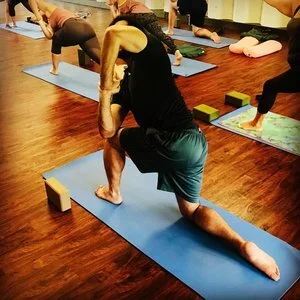One of the things I love about teaching with a translator is how it slows everything down.
Slowly moving with the breath is really where it’s at in a flowing practice. If you can control your breath, you can control your mind.
Let the breath lead the movement and let the breath wrap around the movement. The breath starts and then the movement starts. The movement finishes and then the breath finishes. This way there’s always going to be pauses. There’s always going to be control. Who’s driving your car? You are. Enjoy the dance between the movement and the stillness. Holding these opposites at the same time is the paradox that allows us to have a deeper, transformational experience. Concentrate but also surrender.
Practicing a slow flow that is connected to the breath will help you stay calm and keep you out of the default network of your brain - where it will be hard for you to not react and get caught up in everything that is coming up for you and just trying to process. Think of the four parts of the breath. There’s a little moment of stillness where the inhale meets the exhale, and another little moment of stillness where the exhale meets the inhale.
I love flowing with my students! I always practice a little bit with my students in every class. I find it helps me to connect with the group energy. I also think it reminds the students that I’m just walking the path with them. I’m not on a pedestal. I don’t want to be on a pedestal. We are all just walking home together.
Control Your Breath, Control Your Mind.
The breath is so important in a physical yoga practice. The yogis say, “if you can control your breath, you can control your mind.” Breathe deeply. Breathe down into the belly. This is called diaphragmatic breathing. Breathe into the side ribs. This is called costal breathing. Yogic breathing is often described as a combination of these two types of breathing. You want your breath to be long and slow. But you don’t want to fill the lungs so much that the collar bones lift and the upper chest lifts up towards the neck. This is called clavicular breathing. It is not recommended during your yoga practice. It stimulates the nervous system and is usually only used when the body is starving for oxygen. Breathe in and out through the nose. Let the breath lead you into the movement in your practice. Let the body follow the breath. Krishnamacharya says, “Let the breath be the Guru and the body be the disciple.” Ujjayi pranayama is very balancing. It can be performed in any asana. The Ujjayi pranayama is used to control the breath and slow it down. We can’t control the breath at the nostrils without using our fingers. But we can control the breath by constructing the throat muscles, as if we are sipping the breath through a tiny straw.
Pranayama today!
We started our practice with lots of pranayama today! And before that we even did some simple breath work. This was our last class together on the retreat. This class was in honor of my teacher, Dharma Mittra, and modeled after his Maha Sadhana practice. These classes offer what Dharma calls the "best of the best", with a sampling of different yoga practices. Breaking down how you are breathing can bring into focus areas where you are creating tension and magnify things you are doing that are making it harder for you to breath. These patterns of tension and things you are doing that are inhibiting the breath need to be undone and let go of before you can make progress in your yoga practice.





